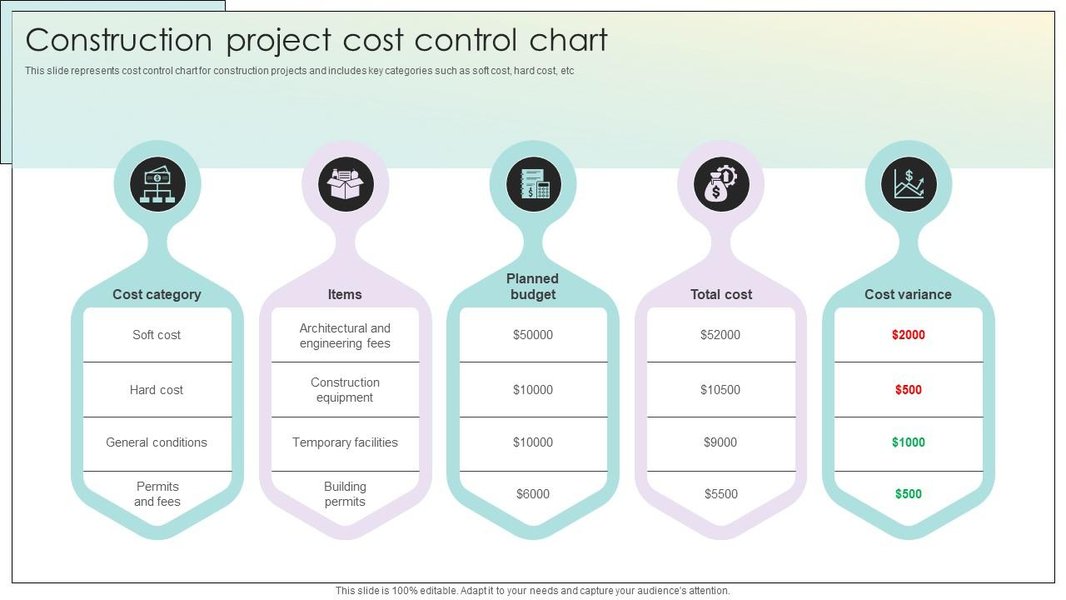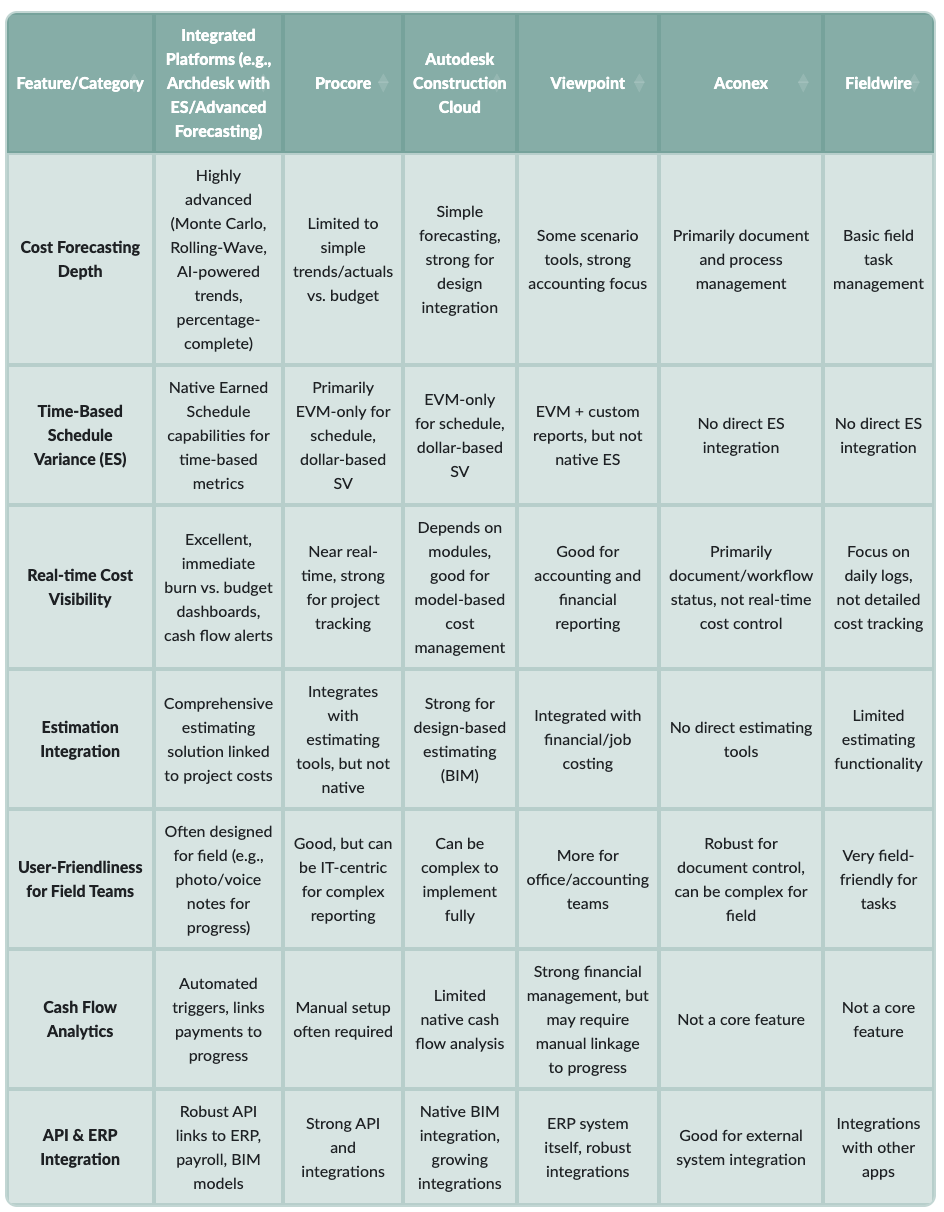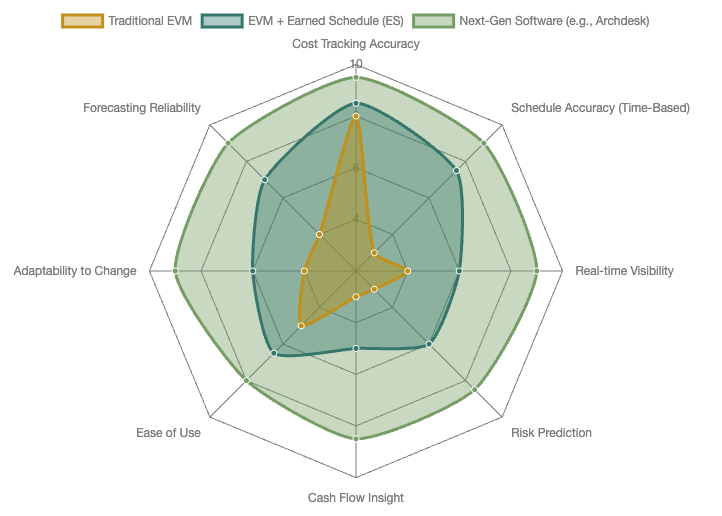Key Insights for Smarter Construction Cost Control
- EVM's Limitations: While traditional Earned Value Management tracks costs well, it often falls short in providing real-time schedule accuracy and can mask critical time delays, leading to project inefficiencies.
- The Power of Earned Schedule: Earned Schedule (ES) directly addresses EVM's time-based blind spots by measuring project progress in units of time, offering a much clearer picture of schedule performance and more reliable completion date forecasts.
- Forecasting the Future: Advanced techniques like Monte Carlo simulations, rolling-wave forecasts, and AI-powered trend analysis provide dynamic, probabilistic predictions, moving beyond static budgets to anticipate risks and opportunities proactively.
- Integrated Solutions: Modern construction software, exemplified by Archdesk, unifies estimating, cost tracking, and advanced forecasting into a single, user-friendly platform, enhancing visibility and enabling data-driven decisions from the first bid to project closeout.
If you're in construction, you know that keeping a lid on project costs can feel like trying to nail jelly to a wall. For years, Earned Value Management (EVM) has been the trusted method for checking project health. It helps you see if you're spending what you planned for the work you've done. But let's be honest, today's construction sites are a whole different ballgame—projects are bigger, supply chains are a mess, and prices for materials can swing wildly. The old ways, while useful, just don't cut it anymore for the fast pace and complexity we face.
This article dives into why EVM, despite its merits, often struggles in the modern construction landscape. Then, we'll explore some exciting new methods that offer more dynamic and accurate control: Earned Schedule (ES) and advanced forecasting techniques. We'll also look at how smart software, like Archdesk, brings these new approaches together, giving you the real-time insights you need to keep projects on track and on budget. We'll sprinkle in examples from companies in the United States and the United Kingdom, keeping it practical and easy to grasp.
The Tried and True: Understanding Earned Value Management (EVM)
What EVM Offers in Project Oversight
EVM is a project management method that ties together project scope, schedule, and resources. It measures performance by comparing how much work was planned versus how much was actually completed, and at what cost. It's like having a dashboard that shows if you're on track, over budget, or behind schedule.
Core Components of EVM:
- Planned Value (PV): This is the budgeted cost of the work you expected to complete by a certain date. Think of it as the value of the work planned to be done.
- Earned Value (EV): This represents the budgeted cost of the work you have actually completed. It's about the value of what you've achieved, not just what you've spent.
- Actual Cost (AC): This is the total money you have actually spent on the work completed so far.
By comparing these three, EVM generates key metrics:
- Cost Variance (CV): ( CV = EV - AC ) (Positive means under budget, negative means over budget).
- Schedule Variance (SV): ( SV = EV - PV ) (Positive means ahead of schedule in terms of value, negative means behind).
- Cost Performance Index (CPI): ( CPI = EV/AC} ) (Greater than 1 is good, less than 1 means over budget).
- Schedule Performance Index (SPI): ( SPI = EV/PV ) (Greater than 1 is good, less than 1 means behind schedule).
EVM provides an integrated view of project health, acting as an early warning system for cost overruns or schedule delays. It gives project managers objective data for decision-making. However, while good for "predictive projects" like many construction jobs, it might not be the best fit for all situations.
The Cracks in the Old Pavement: Why EVM Falls Short
Even with its benefits, EVM has some significant drawbacks, especially with today's complex construction projects. It's like having a powerful engine but without proper steering for sharp turns.
Key Limitations of Traditional EVM:
- Schedule Blind Spots: One of the biggest issues is how EVM measures schedule performance. Schedule Variance (SV) is expressed in monetary terms, not time. This means if you're way behind schedule but have completed all the work planned up to that point, your SV could look good, even zero, which is misleading. It doesn't tell you how many days or weeks you're actually delayed. For example, a UK rail upgrade might show SPI=1 in the final week because costs align, but the track is unfinished. No early warning was given.
- Data Overload and Accuracy: EVM needs precise, real-time data across thousands of tasks. In reality, teams spend hours wrestling with outdated work breakdown structures (WBS) and trying to get accurate progress reports. If the data going in is "garbage in, garbage out," the results are useless.
- Static Snapshots: EVM relies on data gathered at specific "update points." It doesn't give you real-time information between these points. Small overruns or delays can hide until the next report, which can be a problem in fast-moving projects.
- Payment Silos: EVM doesn't track payment cycles. Contractors might delay work due to cash flow issues, even if EVM shows "earned value." A UK high-rise project, for instance, hit EVM targets but stalled because subcontractors halted work waiting for payments, a critical blind spot for the client.
- Baseline Dependency: EVM is heavily tied to the initial baseline. If that baseline isn't accurate, or if the project deviates a lot, the EVM metrics can become less useful.
- Resource and Indirect Costs: Some argue that EVM doesn't fully account for the initial resource mobilization phase or construction indirect costs.
Consider a US example: MetroBuild, a hypothetical firm in Chicago, was building a high-rise. They used EVM but faced unexpected delays due to weather. EVM only showed the financial impact, not the accumulating time slippage. Similarly, London Constructs on a rail project in the UK struggled when parts arrived late; EVM gave them cost data but didn't help predict the ripple effects of the time delay.
The Time Advantage: Embracing Earned Schedule (ES)
Fixing EVM's Schedule Shortcomings with Time-Based Metrics
This is where Earned Schedule (ES) comes in. ES is an extension of EVM that directly fixes its schedule performance limitations. Instead of measuring schedule progress in dollars, ES measures it in units of time. This gives you a much clearer picture of how far ahead or behind schedule you actually are.
Key ES Metrics:
- Earned Duration (ED): The point in time on the planned schedule when the current Earned Value (EV) was planned to be achieved.
- Actual Duration (AD): The actual elapsed time from the project start date to the reporting date.
- Planned Duration (PD): The total planned time for the project.
With these, you can calculate:
- Schedule Variance (time) (SV(t)): ( SV(t) = ED - AD ) (Positive means ahead of schedule, negative means behind).
- Schedule Performance Index (time) (SPI(t)): ( SPI(t) = ED/AD ) (Greater than 1 means ahead, less than 1 means behind).
Why ES is a Game-Changer:
- Clear, Time-Based Metrics: ES directly translates schedule performance into days or weeks, making it much easier to understand and act upon. No more puzzling over dollar-based schedule variances!
- Accurate Forecasting: ES provides more accurate predictions of project completion dates. For instance, a Texas highway project using ES identified a critical concrete pour delay in Week 3. EVM showed the project was on budget, but ES revealed a schedule variance that would delay roadwork by 6 months.
- Complements EVM: It uses existing EVM data, so you don't need to gather a whole new set of information. It enhances what EVM already does.
- Consistency: ES shares the same underlying assumptions as EVM, leading to more consistent forecasts when combined with the Critical Path Method (CPM).
For example, in Seattle, Pacific Builders used ES on a waterfront development. They spotted delays from permitting issues early, adjusted resources, and saved weeks. In the UK, Midlands Projects applied ES to a housing estate build in Birmingham. ES tracked a subcontractor falling behind by about 10 days, allowing them to reallocate workers without budget overruns.

A conceptual image illustrating the distinction and benefits of Earned Schedule over traditional Earned Value methods for schedule analysis.
Forecasting the Unknown: Advanced Predictive Techniques
Beyond Baselines: Dynamic Approaches to Cost Prediction
In a world of fluctuating material prices and supply chain hiccups, static forecasts just don't cut it. Modern construction demands dynamic methods that can predict outcomes weeks or months ahead, helping teams proactively manage risks and opportunities.
Key Advanced Forecasting Techniques:
- Never Stop Re-forecasting: Construction projects are dynamic, with constant changes in materials, labor, and site conditions. Regularly re-forecasting your costs helps you stay agile and make informed decisions, leading to better project control and fewer surprises. This moves beyond merely tracking budgets to continuous adaptation.
- Monte Carlo Simulations: These probabilistic models run thousands of "what-if" scenarios. They assign probability distributions to cost drivers (like material costs, labor rates, or unforeseen delays) and simulate various project outcomes. This provides a range of possible costs and completion dates, along with probabilities, which is excellent for understanding and quantifying risk. A London office tower project, for instance, used Monte Carlo to predict material shortages, allowing the team to secure bulk discounts on steel months in advance. US heavy-civil firm NextGen Construction used Monte Carlo on a highway expansion, identifying a 20% chance of a significant overrun, prompting leadership to approve a contingency.
- Rolling-Wave Forecast: This approach sets high-level numbers for far-off project phases and detailed numbers for the immediate 8-12 weeks. As the project moves forward, more detail is added to subsequent phases. This is ideal for long-term projects with evolving details. A London hotel fit-out, for example, used a 6-month rolling forecast, updating cost-to-complete every two weeks, which cut forecast variance significantly. UK's Mace Group used rolling-wave forecasting for a mixed-use tower, demonstrating its utility in complex, long-duration projects.
- Reference Class Forecasting: This technique involves looking at similar past projects to predict outcomes for current ones. If a firm has built 50 houses of a certain style, that historical data can be used to forecast costs for the 51st. Balfour Beatty UK uses an internal database of over 100 office refurbishments for this, baking in historical cost growth ranges to trim surprises.
- Artificial Neural Networks (ANN) and Machine Learning: These advanced techniques learn from vast amounts of historical project data to identify patterns and make highly accurate cost predictions. They can adapt to new information and changing conditions, moving beyond manual tracking.
- Percentage-Complete Forecast: This method estimates how much more money is needed to finish the project based on the work already done (cost-to-complete calculation).
The Digital Catalyst: Next-Generation Construction Software
Unifying Cost Controls with Integrated Platforms
The ability to implement ES and advanced forecasting effectively often relies on modern construction management software. The days of relying solely on spreadsheets are fading. Today's tools offer powerful capabilities:
- Centralized Data: They gather all project data—from estimates to actual expenditures—into one place, providing a "single source of truth" that is essential for accurate forecasting and performance tracking.
- Real-time Tracking: Software allows for continuous monitoring of costs against budgets. This means you can spot cost overruns or issues as they happen, not weeks later.
- Automation: Many administrative tasks and calculations can be automated, saving time and reducing errors. This frees up project managers to focus on analysis and decision-making.
- Advanced Analytics: These platforms can crunch numbers, identify trends, and even use AI to predict future costs and suggest optimizations.
- Integration: The best software integrates different project processes, from estimation and tendering to procurement and financial accounting, providing a unified view.
Archdesk: An Example of Modern Cost Control Integration
Archdesk is a great example of software that helps contractors manage their finances from start to finish. It assists with everything from quick cost estimates to detailed financial planning and analysis. Imagine a builder using Archdesk:
- Accurate Estimates: They can use Archdesk's estimation solution to create precise bids, pulling data from cost catalogs and using formulas. This is a big step in getting costs right from the start.
- Budget Planning: With financial planning tools, a solid budget can be set up, acting as the project's baseline.
- Real-time Cost Tracking: As work progresses, the system tracks actual costs against the budget. If materials come in over budget or labor hours are higher than expected, the system flags it immediately. This "real-time tracking" is key to catching potential overruns early.
- Continuous Re-forecasting: Project managers can easily re-forecast based on the latest actuals and market conditions. This allows for quick adjustments, like if tariffs on materials suddenly increase.
- Performance Analysis: The software shows how well the project is doing against both the budget and the plan, increasing visibility into overall performance.
Case study: Skanska's rail line project in the UK faced material shortages. Archdesk’s AI predicted these shortages, triggering early purchases, which resulted in 25% fewer project halts and 8% cost savings. US-based Jones CPA Group rolled out Archdesk and dramatically reduced budget report preparation time, flagging concrete cost overruns three weeks early by integrating real-time purchase orders.

A glimpse into the Archdesk project management interface, showcasing its integrated features.
Competitive Landscape: Comparing Tools
While many excellent construction software platforms exist, their strengths vary. Here's a look at how an integrated approach with tools like Archdesk stacks up against some competitors in key areas:

Visualizing Performance: A Radar Chart Comparison
Assessing Different Cost Control Approaches
To better understand the strengths of traditional EVM, EVM enhanced with Earned Schedule, and a comprehensive next-generation software like Archdesk, let's look at a radar chart. This chart helps us compare how each approach performs across critical aspects of project cost control and schedule management.

This radar chart illustrates the perceived capabilities of different cost control approaches:
- Traditional EVM: Shows strong capabilities in "Cost Tracking Accuracy" as it's designed for that, but falls short in "Schedule Accuracy (Time-Based)" and "Real-time Visibility" due to its inherent limitations.
- EVM + Earned Schedule: Significantly improves "Schedule Accuracy (Time-Based)" by adding ES metrics. It also boosts "Forecasting Reliability" as time-based projections are more precise. Its "Cost Tracking Accuracy" remains strong.
- Next-Gen Software (e.g., Archdesk): This approach aims for high performance across all axes. It excels in "Real-time Visibility" and "Cash Flow Insight" due to integrated data, "Risk Prediction" through advanced forecasting, and "Adaptability to Change" because of continuous re-forecasting. "Ease of Use" is also emphasized through user-friendly interfaces, moving beyond the complexity of manual EVM systems. While "Cost Tracking Accuracy" is fundamental, it leverages automation and comprehensive data.
The chart visually highlights how moving "beyond EVM" to a combined ES and advanced software approach provides a much more holistic and effective project control system.
The Roadmap Ahead: A Mindmap of Next-Gen Cost Controls
Navigating the Future of Project Finance
To summarize the interconnectedness of these new approaches and their impact on construction projects, here's a mindmap. It visually organizes the key elements of next-generation project cost controls, showing how they build upon each other to create a more robust system.

This mindmap shows how overcoming EVM's limitations through ES and advanced forecasting, powered by modern software, leads to significant benefits. It's about moving from reacting to problems to proactively managing project outcomes.
Real-World Impact and Future Trajectories
Companies Leading the Way in the US and UK
Many construction firms are already embracing these next-generation controls, seeing tangible benefits:
- Bechtel (US): On a $2B chemical plant upgrade, ES metrics uncovered steel delivery bottlenecks weeks early, reducing delays by 30% and saving $15M.
- Turner & Townsend (US/UK): A $120M hospital job in the US saw early infill delays flagged by ES as a –12-day variance. This allowed them to add a night shift two weeks earlier, saving 8 days overall.
- NextGen Construction (US): This US heavy-civil firm used Monte Carlo simulations on a highway expansion project, identifying a significant chance of overrun, which prompted a pre-approved contingency fund to cover risk areas.
- Balfour Beatty (UK): Utilizes internal databases for reference class forecasting on office refurbishments, baking in historical cost growth ranges to avoid surprises.
- Mace Group (UK): Implemented rolling-wave forecasting for a large mixed-use tower project, allowing them to adapt forecasts every two weeks based on updated cost-to-complete.
Strategic Implementation and Cultural Adoption
Adopting new tools and methods is more than just buying software; it needs team buy-in. It's about a cultural shift:
- Training: Ensure project managers and teams are well-trained on ES concepts and advanced forecasting techniques.
- Show Small Wins: Demonstrate early successes. For example, flagging a $50K pump rental overrun and fixing it in days builds confidence.
- Performance Dashboards: Visualize key performance indicators (KPIs) through easy-to-understand dashboards. Celebrate teams that stay within forecast bands to drive accountability and engagement.
The Horizon: Future Trends in Cost Control
- IoT Sensors: Imagine sensors tracking material usage in real-time, feeding data directly into forecasts for immediate adjustments.
- Blockchain Payments: Automating milestone payments when sensors confirm physical progress could revolutionize cash flow management and transparency.
- Gamified Dashboards: Visualizing KPIs as leaderboards or challenges can drive team accountability and make cost control more engaging.
Frequently Asked Questions
What are the primary limitations of traditional Earned Value Management (EVM)?
EVM primarily struggles with accurately representing schedule performance in terms of time (its schedule variance is dollar-based), relies on periodic snapshots instead of real-time data, and often overlooks critical cash flow issues or resource mobilization costs.
How does Earned Schedule (ES) improve upon EVM?
ES directly addresses EVM's schedule limitations by measuring project progress in units of time (e.g., days, weeks). This provides a clearer, time-based understanding of schedule variance and more accurate forecasts for project completion dates.
What are some advanced forecasting techniques used in modern construction?
Key techniques include Monte Carlo simulations (for risk analysis and probabilistic outcomes), rolling-wave forecasting (for dynamic, iterative planning), reference class forecasting (learning from similar past projects), and leveraging AI/Machine Learning for data-driven predictions.
How do modern construction software platforms like Archdesk support these new methodologies?
Platforms like Archdesk centralize project data, automate calculations, provide real-time cost tracking, and integrate advanced forecasting models (like ES). They offer user-friendly dashboards for enhanced visibility and collaboration between office and field teams.
Can these new cost control methods be integrated with existing project management systems?
Many modern software solutions are designed with robust API (Application Programming Interface) capabilities, allowing them to integrate with existing ERP systems, payroll software, BIM models, and other project management tools, creating a unified data environment.
Conclusion
Earned Value Management isn't obsolete; it's evolving. By layering it with Earned Schedule, dynamic forecasting techniques, and powerful, integrated software platforms like Archdesk, construction teams gain clearer, more actionable data. The future of project cost control isn't about throwing out spreadsheets entirely, but rather using them as one piece of a much smarter, more comprehensive puzzle. This proactive, data-driven approach means fewer surprises, better decision-making, and ultimately, more profitable and successful projects in the complex world of modern construction.
References
Cost Forecasting in Construction - Archdesk
Construction Cost Forecasting: How to Hit Your KPI - Mastt
Comparison of 8 Common Forecasting Methods - PM World Library
Earned Schedule: A Powerful Enhancement to EVM - Hexagon
EarnedSchedule.com - Official Site
Artificial Neural Networks, Cost estimation - IRJET





